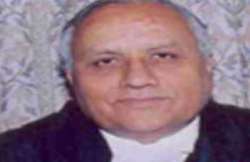Hindu Temple Remnants Used To Construct Babri Masjid: Judge
New Delhi, Oct 1 :Remnants of demolished Hindu temples were used to build the Babri Masjid, Justice Dharam Veer Sharma of the Lucknow Bench of the Allahabad High Court has held and cited evidence provided

New Delhi, Oct 1 :Remnants of demolished Hindu temples were used to build the Babri Masjid, Justice Dharam Veer Sharma of the Lucknow Bench of the Allahabad High Court has held and cited evidence provided by the ASI to support the findings.
"On the basis of circumstantial evidence, historical accounts, gazetteers 361 and other epigraphical documents, it is established that after demolishing the temple the disputed structure was constructed as a mosque and even pillars of the old temple were re-used which contained the images of Hindu Gods and Goddesses against the tenets of Islam," he said in his judgement yesterday.
"Thus, the circumstantial evidence totally contradicts the assertion of Muslims. I have already referred the oral evidence, adduced by the parties in Annexure No.5. I conclude that the oral evidence led by Muslims is not trustworthy. Thus the circumstantial evidence conclusively establish the claim of Hindus about the destruction of old temple and construction of Babri Mosque at the site of the temple which is corroborated by the expert evidence of ASI"
According to the Judge, of the 265 inscriptions found on 6.12.1992 after demolition of the disputed structure along with other architectural remains leave no room for doubt that the inscription is written in the script of Dev Nagri of 11th and 12 century.
"I have also referred English translation of 20 line inscription of Dr K B Ramesh. The aforesaid circumstantial evidence supported by other epigraphical documents are the most valuable evidence which fully corroborate the version of Hindus and belies the version of Muslim that the mosque was not constructed, after demolishing any temple," the Judge said.
The Judge said on the basis of the opinion of the experts, evidence on record, circumstantial evidence and historical account from all or any angle, it transpires that the temple was demolished and the mosque was constructed at the site of the old Hindu temple by Mir Baqi at the command of Babur. PTI
"On the basis of circumstantial evidence, historical accounts, gazetteers 361 and other epigraphical documents, it is established that after demolishing the temple the disputed structure was constructed as a mosque and even pillars of the old temple were re-used which contained the images of Hindu Gods and Goddesses against the tenets of Islam," he said in his judgement yesterday.
"Thus, the circumstantial evidence totally contradicts the assertion of Muslims. I have already referred the oral evidence, adduced by the parties in Annexure No.5. I conclude that the oral evidence led by Muslims is not trustworthy. Thus the circumstantial evidence conclusively establish the claim of Hindus about the destruction of old temple and construction of Babri Mosque at the site of the temple which is corroborated by the expert evidence of ASI"
According to the Judge, of the 265 inscriptions found on 6.12.1992 after demolition of the disputed structure along with other architectural remains leave no room for doubt that the inscription is written in the script of Dev Nagri of 11th and 12 century.
"I have also referred English translation of 20 line inscription of Dr K B Ramesh. The aforesaid circumstantial evidence supported by other epigraphical documents are the most valuable evidence which fully corroborate the version of Hindus and belies the version of Muslim that the mosque was not constructed, after demolishing any temple," the Judge said.
The Judge said on the basis of the opinion of the experts, evidence on record, circumstantial evidence and historical account from all or any angle, it transpires that the temple was demolished and the mosque was constructed at the site of the old Hindu temple by Mir Baqi at the command of Babur. PTI